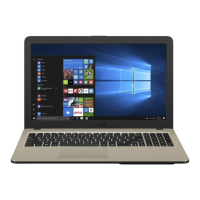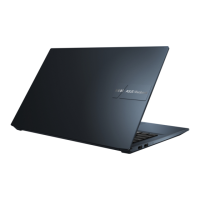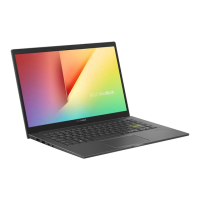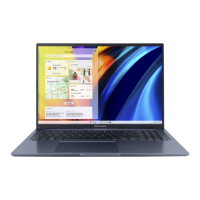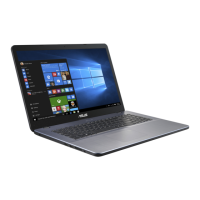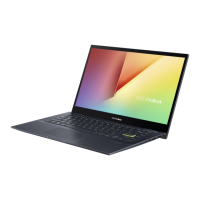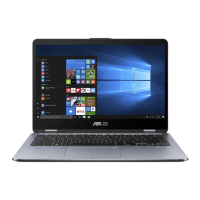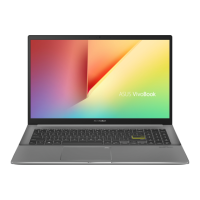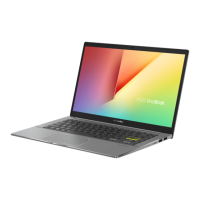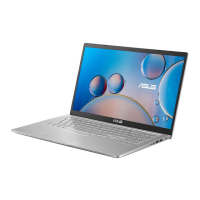
Do you have a question about the Asus VivoBook 15 F515JA and is the answer not in the manual?
| RAM | 8GB DDR4 |
|---|---|
| Graphics | Intel UHD Graphics |
| Operating System | Windows 10 Home |
| Wireless Connectivity | Wi-Fi 5(802.11ac) + Bluetooth 4.1 |
| Processor | Intel Core i3-1005G1 |
| Display | 15.6-inch, FHD (1920 x 1080) |
| Storage | 512GB SSD |
| Weight | 1.8 kg |
| Battery | 37WHrs, 2-cell Li-ion |
| Dimensions | 360.2 x 234.9 x 19.9 mm |
| Ports | 1 x USB 3.2 Gen 1 Type-C, 1 x USB 3.2 Gen 1 Type-A, 2 x USB 2.0, 1 x HDMI, 1 x audio combo jack |
Explains the use of text formatting, icons, and typography for clear communication in the manual.
Details the top view of the notebook, highlighting components like camera, display, keyboard, and touchpad.
Details the bottom view of the notebook, focusing on air vents and audio speakers.
Details the right side ports and status indicators, including battery and power indicators.
Details the left side ports, including power input and various connectivity ports.
Guides on initial setup, including charging the notebook and powering it on for the first time.
Explains various touchpad gestures for navigation and interaction, including one-finger, two-finger, and multi-finger gestures.
Details keyboard functions, including HotKeys for special commands, Function keys, and Windows 10 keys.
Explains the functionality and usage of the numeric keypad for input and pointer direction.
Guides through the initial Windows 10 setup process after powering on the notebook for the first time.
Explains the Start menu as the main gateway to programs, apps, folders, and settings in Windows 10.
Describes Windows apps displayed in tiled format on the Start menu for quick access.
Details how to launch, customize, and close Windows apps using the touchpad or keyboard.
Explains how to switch between apps and desktops using the Task View feature.
Describes the Snap feature for displaying apps side-by-side for multitasking.
Explains the Action Center for consolidating notifications and accessing Quick Actions.
Lists various keyboard shortcuts for launching applications and navigating Windows 10.
Guides on connecting the notebook to a Wi-Fi network for internet access.
Explains how to use Bluetooth for wireless data transfers and pairing with other devices.
Details how to turn Airplane mode on and off to disable wireless communication.
Provides procedures for shutting down the notebook normally or forcefully.
Explains how to put the notebook into Sleep mode via the Start menu or power button.
Defines POST as diagnostic tests run during startup to check system hardware.
Explains how to access BIOS settings or troubleshooting options during POST.
Explains BIOS stores system hardware settings for startup and advises against changing defaults.
Provides methods to enter BIOS settings, either by restarting and pressing F2 or via Windows advanced startup.
Explains how to restore the system to its original state or refresh settings using recovery options.
Details steps to access and use recovery options like 'Reset this PC' or 'Advanced startup'.
Offers tips for maximizing usage, maintaining performance, and securing data, including updates and backups.
Addresses common hardware-related questions and troubleshooting for the notebook.
Addresses common software-related questions and troubleshooting for operating system and application issues.
Provides information about the DVD-ROM drive and optional viewer software.
Explains DVD region definitions and playback restrictions based on geographic regions.
Provides information about the Blu-ray ROM drive for viewing HD videos.
Details compliance of the internal modem with various regulatory standards like JATE and FCC.
Outlines FCC compliance rules regarding harmful interference and device operation.
Provides caution statements regarding FCC RF exposure limits and user compliance.
States compliance with Canadian ISED standards for wireless devices.
Details safety precautions required by UL standards for telecommunications and battery usage.
Advises against listening at high volume levels for long periods to prevent hearing damage.
Cautions regarding the danger of explosion if lithium-ion batteries are replaced incorrectly.
Warns about explosion risk from incorrect battery replacement and recycling requirements.
Declares compliance with EU Directive 2014/53/EU for the device.

